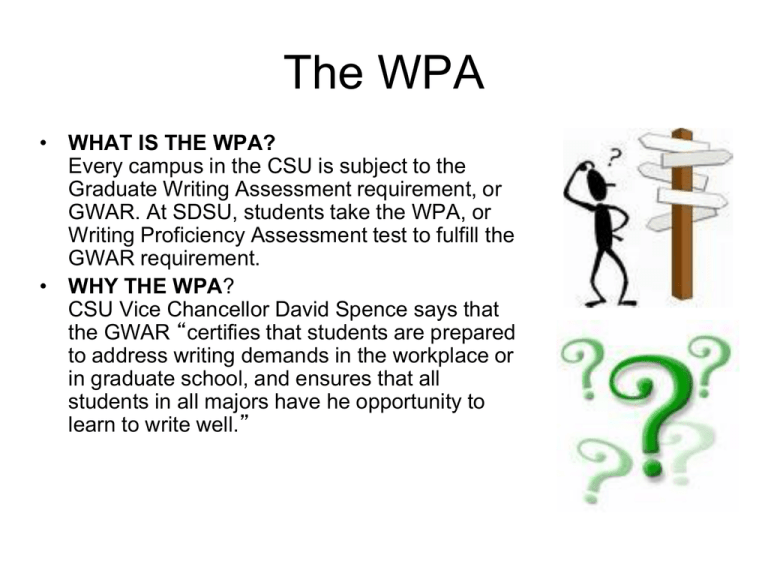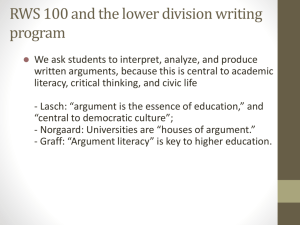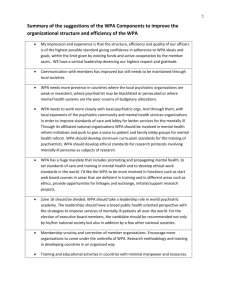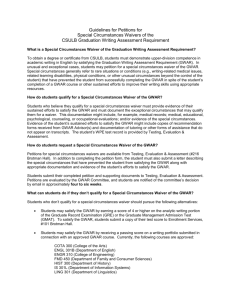THE WPA
advertisement

The WPA • WHAT IS THE WPA? Every campus in the CSU is subject to the Graduate Writing Assessment requirement, or GWAR. At SDSU, students take the WPA, or Writing Proficiency Assessment test to fulfill the GWAR requirement. • WHY THE WPA? CSU Vice Chancellor David Spence says that the GWAR “certifies that students are prepared to address writing demands in the workplace or in graduate school, and ensures that all students in all majors have he opportunity to learn to write well.” What does the WPA focus on? • “The WPA focuses on your ability to read and analyze written arguments. It measures your ability to express yourself clearly, logically and specifically and to organize and develop your ideas well. In addition, it assesses your ability to write coherent paragraphs and appropriately structured sentences.” What does the WPA focus on? • “You will be given a short reading in the form of an argument and asked to write an essay that responds to a series of questions that relate directly to the reading selection. The questions you will be asked to address in the essay will focus specifically on analysis of the argument presented in the reading rather than a personal response. You will be asked to assess the argument's structure, to explain how the author uses rhetorical strategies to persuade an audience, and to evaluate (using evidence from the reading itself) how convincing the argument is…You will be allotted two hours to complete the exam.” A Sample WPA Exam Question • “Craft a coherent essay (i. e. one that is not just a series of paragraph responses to the prompt) in which you respond (in an appropriate order) to all of the following components: Identify and provide a brief explanation of the author’s argument; Describe and discuss two strategies that the author uses to support his or her argument; Describe the overall structure of the reading selection and explain whether it furthers the aims of the author’s argument; Discuss the premise(s) and/or assumption(s) on which the argument is based; Evaluate the extent to which you find the argument convincing.” Key Terms Used in the WPA • Here are some terms to look for along with brief definitions: • Brief Explanation: Requires you to put the author’s argument in your own words. You want to keep this as brief as possible by limiting this discussion to only 1 paragraph. • Describe, Explain, Discuss: Moving beyond summary, these terms require you to analyze, to go beyond what is written to how it is written. Effective description, explanation, and discussion are objective and impersonal, rather than subjective. Furthermore, they employ specific, direct, concrete language. [Do versus say] Key Terms Used in the WPA • Strategies: Strategies are moves or devices that help build and support arguments. Commonly used strategies include examples, statistical support, appeals to the emotions of the reader (pathos), demonstrations of authorial credibility (ethos), analogies and comparisons, irony, refutations of opposing arguments, and quotations from experts and famous sources. Stylistic devices such as repetition, alliteration, and metaphor can also be characterized as strategies. • Evaluate: More subjective than objective analysis, evaluation requires judgment and assessment based on explicit criteria, reasoning, and evidence. Evaluating an argument goes beyond declaring whether or not you agree with it. You are required to assess how its strengths and weaknesses contribute to or undermine its convincingness. Attention to the writer’s efforts to respond to potential opposition is particularly important. Key Terms Used in the WPA • Structure: The way a piece of writing develops and unfolds over time. • Premise and Assumption: Treated as synonyms in this assignment, premises and assumptions are the principles, propositions, beliefs, and values upon which arguments or parts of arguments rest. Premises and assumptions can be explicitly stated or implicit (merely implied or suggested) in an argument. They are effective to the extent they come to be shared by the reader and writer, thus forming “common ground.” Frequently Asked Questions • Q: When do I take the WPA? A: Continuing students must take the WPA during the semester in which they are completing 60 units or in the semester immediately following. Transfer students are eligible to take the WPA once they have received an offer of admission. They must take the examination by the end of their first semester at SDSU. • Q: How many times can I take the WPA? A: Students are allowed to attempt the WPA twice within the time frames and restrictions described in the question above. • Q: What happens if I don't take the WPA during the required time frame? A: Students who do not take the examination by the end of the required time frame will not be able to register for future terms. FAQ Q: Can I see sample WPA tests and explanations of how they were scored? A: see the GWAR site: http://www-rohan.sdsu.edu/~gwar/samples.html Q: What are the scoring criteria? A: They are listed here, and connect closely with skills covered in RWS 100 http://www-rohan.sdsu.edu/~gwar/scoring.html RWS 280 Score 7 or less RWS 281 (ESL) RWS 305W (General/ Engineering) (60 credits) RWS 100 RWS 200 WPA Score 8 or 9 Score 10 RWS 503W (Professions) RWS 500 (Grad Writing) No "W" class req'd unless major req's it: English, History, etc. (See your advisor) Tips • You will likely take RWS 200 next semester. • I suggest you take the WPA right after that, when you are most familiar with material from RS 100 and 200. • If you take it early and don’t score well, you can take it a second time and still have plenty of time to prepare (rather than leaving it late, when you are getting ready to graduate.) For more info… • See the WPA site: http://www-rohan.sdsu.edu/~gwar














